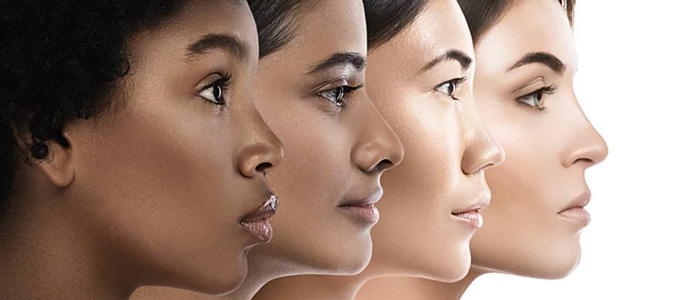Rhinoplasty surgery aims to restore an ideal appearance by changing the shape and size of the nose. There are various techniques and forms of rhinoplasty. These methods are applied in both ethnic rhinoplasty and traditional rhinoplasty. Procedures may vary from patient to patient. So, what are the differences between ethnic and traditional rhinoplasty?
What is Ethnic Rhinoplasty?
Ethnic origins are influential in the formation of physical features. Nose types have characteristic features that may differ from origin to origin. For example, the nose shapes of Asians, Latinos, Africans and Europeans can be easily distinguished from each other. Ethnic rhinoplasty aims to preserve the physical characteristics of the patient’s origin and to provide an individualized improvement. It is aimed to perform aesthetic surgery by taking into account the patient’s genetic structure and physical characteristics. The aim is to achieve a more natural appearance without distorting the patient’s face shape.

Asian Rhinoplasty
Nose shapes and types vary according to different ethnicities. There are no standard rhinoplasty techniques suitable for every face. The methods to be used vary according to patient expectations, origin and nose shape. The Asian nose is less bony and flattened than the western nose types. In order to make the nose look ideal, procedures such as enlarging the bridge of the nose, thinning the wings of the nose and flattening the back of the nose are the first choices for those who have Asian rhinoplasty. In Asian rhinoplasty surgery, cartilage addition and augmentation procedures may be needed.
Latin Rhinoplasty
People of Latin ethnic origin may have wide nostrils, arched nasal ridges and wide nasal tips. Although the procedures applied in Latin rhinoplasty are closer to traditional rhinoplasty, there are differences. While determining the shape and size of the nose, an ideal appearance is achieved without moving away from the natural face shape. In patients who have Latin rhinoplasty, the back of the nose is made straight or curved, while the tip of the nose is brought to a more ideal appearance.
African Rhinoplasty
People of African descent or African-Americans have flatter nasal ridges and wider nostrils and wings. The prominent nasal tips and high nasal bridge usually attract attention. The procedures generally applied for those who want to have African rhinoplasty surgery are flattening the dorsum of the nose and narrowing the wings of the nose. It is also preferred to sharpen the tip of the nose. The procedures can also be shaped according to the patient’s expectations.
What is Traditional Rhinoplasty?
Due to the European perception of beauty, traditional rhinoplasty is focused on nose reduction. Noses suitable for Western standards can be upturned, thin and small. Traditional rhinoplasty is performed according to a certain standard. Although it is individualized according to the patient’s needs and surgeon supervision, the procedure is the same. In classical rhinoplasty surgery, closed rhinoplasty and open rhinoplasty techniques can be applied. The method to be used varies according to the patient and the physician.

In closed rhinoplasty surgery, an incision is made inside the nostrils, and since there is no incision on the visible part of the skin, there is no surgical scar. In open rhinoplasty surgery, an incision is made both under the tip of the nose and inside the nostrils. Open rhinoplasty is more extensive and allows for more detailed changes in the nose. From a cosmetic point of view, there may be a surgical scar under the tip of the nose, but it improves with wound creams and over time.
Caucasian Rhinoplasty
The noses of Caucasian patients generally have a low nasal tip, an arched back and asymmetrical nostrils. The type of surgery considered suitable for Caucasian races is usually the traditional closed rhinoplasty method. Detailed intervention is required for the dorsum, tip and wings of the nose, while a detailed visual angle is required for cartilage addition/removal procedures. The procedures to be applied for the noses of Caucasian patients are generally procedures identified with classical rhinoplasty such as nose reduction, cartilage and bone removal.
What are the main differences between traditional rhinoplasty and conventional rhinoplasty?
In traditional rhinoplasty, the standard procedure is applied to everyone as it aims for a small, thin “ideal” nose in accordance with western standards. In ethnic rhinoplasty, on the other hand, the anatomical structure of the patients and the physical features specific to their ethnic origin are taken into consideration; a unique nasal appearance is designed in accordance with the facial features of the person. With ethnic rhinoplasty, which can also be called personalized rhinoplasty, ethnic characteristics are preserved and a unique approach is adopted by taking individual preferences into consideration.
Which Rhinoplasty Surgery is Right for Me?
The techniques and methods used in rhinoplasty surgery may vary according to the patient’s expectations, genetic status and surgeon experience. While ethnic rhinoplasty may be more suitable for those of African, Asian, Latin and Asian origin, those who want a rhinoplasty in accordance with Western beauty standards can benefit from traditional rhinoplasty. At this stage, determining the aesthetic purpose and expectations will help to make a choice. When choosing a surgeon, it is also important to choose according to the specialty of the physicians; it is important to investigate their areas of experience.
You can contact the Clinic Evoy team to find out the type of rhinoplasty suitable for you and to have a comprehensive evaluation. Clinic Evoy continues to be the first choice of thousands of patients for rhinoplasty surgery with its expert doctors. Call now to get more information from Clinic Evoy, which offers a unique experience with its advanced technology medical equipment, specialist physicians and price policy, and to take advantage of the privileges it offers!

